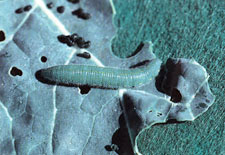Categories
Calendars
Guides
Reviews
Archive
Gallery
Articles
Ask Our Gardening Expert
Cabbage Caterpillars and Moths
Cabbage Caterpillars and Moths Mamestra brassicae - Cabbage Moth Of the three above, the Small Cabbage White is
the most common and does the most damage.
The life cycle is as follows. The adults appear
in mid-spring and lay single eggs on the leaves of cabbage,
cauliflower, Brussels sprouts, kale and kohlrabi. The eggs are
yellow, oblong and ridged lengthwise. They hatch in around 5
days depending on weather conditions. Initially they feed on the
outer leaves, but as they mature, they tend to go for the heart
leaves. They reach about 2.5 cms (1 inch) in length after a
couple of weeks. Around this stage they pupate into a chrysalis
and it is from these chrysalis that more butterflies and moths
will emerge. The final generation of each year over-winters as a
chrysalis.
The caterpillars can be identified as follows: Cabbage Moth - green-brown all over with no 'hair' The damage is caused by them eating the leaves,
both the outer leaves and more annoyingly leaves at the heart of
cabbages. The holes are no particular shape and are
irregular. How to Treat Cabbage Whitefly An alternate solution is to protect the plants
with netting or some other form of covering especially made for
the purpose. These are readily available from nurseries, garden
centres and DIY stores. A spraying with derris will also
help and will not cause damage to wildlife. Once the caterpillars have got to the heat of
the cabbage, it's very difficult to treat with anything but
chemicals. Spray with an approved chemical
but follow the instructions on the packet carefully.
There are three common caterpillars which feed on brassicas:
Pieris brassicae - Large Cabbage White Butterfly
Pieris rapae - Small Cabbage White Butterfly It is the caterpillars which do the damage
rather than the moths or butterflies. The damage occurs between
April and October because each of the varieties has two or more generations from spring to autumn.
It is the caterpillars which do the damage
rather than the moths or butterflies. The damage occurs between
April and October because each of the varieties has two or more generations from spring to autumn.
Large Cabbage White - a yellow body with dark black markings all
over the body.
Small Cabbage White - these are pale green all over with a
velvet looking texture.
These caterpillars can cause considerable damage
to cabbage plants especially if they get to the heart leaves. It
really is best to keep a regular check going for damage and take
action immediately it is noticed. The best solution is to remove
the caterpillars by hand when they are young and still on the
outer leaves.